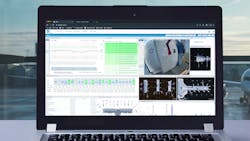In our connected, increasingly digital world, data supplies critical information. And with this information, insights can be realized and operational improvements can be implemented, saving valuable time and money. This is especially true of ground support equipment (GSE) and the way it is used by aviation personnel.
Initially utilized to improve maintenance practices – particularly preventative maintenance (PM), the use of telematics has evolved in the GSE industry, allowing manufacturers, managers and frontline personnel to better understand how equipment is functioning in the field.
JBT product manager Bill Poulsen notes his company’s telematics solution, iOPS, has been in use for more than 10 years. However, the way collected data is applied continues to change.
“What it has really evolved into is more of a platform for the users to actually control their whole operations much more effectively. It’s not just about maintaining the equipment. It’s about all that data that’s collected and using that to better run their operations out in the field,” he says.
“When we talk iOPS, it really means intelligent operations,” Poulsen continues. “Over the last two years, we’ve gone from really just collecting data and using it to do the maintenance, to actually perform the operations better.”
At TLD, the company’s Link system offers an end-to-end solution for GSE fleet management based on telemetry technology, explains Driss Mahjoub, group chief technical officer for the TLD group.
“The Link retrieves and filters data from the ‘heart’ of the machine in order to provide actionable dashboards and alerts to the end-user,” he says. “Link is a fleet supervision software allowing the customer to locate the machines, to understand their real operational status and optimize their operation, to detect safety risks, if any, and to support fault diagnosis and maintenance activities.”
Through customer collaboration, telematics have been enhanced in multiple ways.
For example, Mahjoub notes Link’s User Experience field was upgraded to improve the end-user interface to make finding relevant information easier.
“In addition, we have continuously increased the amount of available data from the machine and the associated KPIs. Last but not the least, we have improved data accuracy,” Mahjoub adds.
Poulsen says it is common to meet with customers on a monthly or even bi-weekly basis to demonstrate incremental improvements and added features that are regularly being integrated into iOPS.
“We work together with them so we can make this platform much, much better,” he says.
Chief among the improvements made to iOPS is the company’s tactical dashboards, which allow hundreds of data points on multiple pieces of equipment to be sorted and presented efficiently to each level of an organization.
“How do you present that in a way that means something to the customer?” Poulsen posits. “They don’t necessarily want to know all the numbers. Like what’s the temperature of the exhaust? What’s the temperature of the coolant fluid? Somebody in their organization wants to know, but the management levels don’t really need to know that. They want to know that things are operating, how well they’re performing, how well not just the equipment is performing, but how their operators are performing.
“That’s some of the kinds of things we can address.”
Collecting Data
The range of data that can be collected from GSE assets is vast.
“Link is able to retrieve a goldmine of data such as localization, speed, trajectory, historical routing, battery state-of-charge and state-of-health and much more technical data such as including current level, battery and motor temperatures, fault codes, etc.,” Mahjoub says
Many data points can assist with costs savings, environmental goals and safety initiatives.
Poulsen notes geofencing and speed-monitoring can ensure that equipment is operated correctly based on its physical location.
“iOPS really effects the safety of the operation,” he says. “It makes it more efficient and also gives the ability to actually have the customer save money.”
Poulsen adds that monitoring fuel levels and usages is helpful because sometimes operators let equipment idle in between uses. When this happens, information is reported back to an operations manager, who can address the issue with ground personnel. Similarly, monitoring deicing fluids can reduce operational costs.
“The combination of controlling the usage of the fuel and also the usage of the deicing fluid helps things be more environmentally appropriate,” Poulsen adds.
But with numerous data points on each piece of equipment, managing the information can seem daunting. To help customers consume this information, dashboards become important for GSE fleet management.
“Link has pre-set dashboards in the areas of safety, fleet supervision and equipment fault diagnosis,” Mahjoub explains, noting customized reports can be created or alerts via email or SMS can be triggered by specific events.
Poulsen refers to JBT’s tactical dashboards available within iOPS as “perspectives.” The interface can be adjusted based on the type of data a customer is looking for.
“Everybody within a company has a different perspective on the data that they need to use on an everyday basis,” Poulsen explains. “You might have a corporate manager. He needs to know the things related to money and finance. An operations manager at an airport needs to know where his equipment is, whether it’s up and running, whether it’s ready to go, who’s using it right now, how it’s being used and that sort of thing.
“We have these different perspectives that we create that essentially only present the data that’s needed by that particular function within a customer’s company,” he continues. “The highest level person in the company actually needs to know less specific data about that equipment than the guy that’s down there in the field, repairing that equipment. [The service technicians] need to know those things – like temperatures and wear information – so they can do their job.”
Since too much data runs the risk of overwhelming new users, the concept of dashboards is designed to declutter data and make information easier to digest.
Applying Data
The purpose of telemetry is not just displaying data, but more importantly analyzing the data. The way data is applied to GSE is important, and Poulsen uses routine maintenance as an example.
“Traditionally, people have gone by usage hours – how many hours has that equipment been used? – to determine a maintenance activity,” he says. “What we’re doing now is combining multiple sub-level elements that might look at engine temperatures, might look at engine RPMs, might look at fuel usage. We can look at things like how many times has a joystick been moved back and forth.”
All of these sub-level parameters that contribute to the wear on of a piece of equipment can be considered when determining exactly when maintenance needs to take place.
“One parameter might tick down quicker than another parameter based on how it’s being operated,” Poulsen says. “That will also trigger things like an email alert.”
Mahjoub points to improved safety and security as a key application of telematics as speeding, parking violations and vehicle access control can be monitored.
“Also, allocation of GSE equipment can be optimized considering the various missions scheduled for the day vis-a-vis state-of-charge of the battery or pending maintenance,” he says.
“Telematics enable efficient opportunity charging in between missions, which is a key for electrification of ramp motorized GSE,” Mahjoub continues. “Another benefit may come from better fleet utilization and lower cost of ownership through pooling across various operators. There are many other use cases.”
During the warranty period, JBT representatives use iOPS to access data remotely and walk customers through troubleshooting and repairs.
“We can actually look at the state of the equipment prior to sending a field service engineer out and have an indication of what the real issue is,” Poulsen says.
Beyond warranty claims, remote access to data offers benefits related to ramp operation safety, fleet supervision, operation management and tele-diagnosis, according to Mahjoub.
“Monitoring vehicle speed on the ramp, as simple as it sounds, is an effective way of preventing accidents, reducing human injuries and aircraft damage. Obviously, the geo-localization of a unit at any point in time allows, as well, a much leaner operation all around, reducing down-time and unit transit time between operating zones on the airport,” says Mahjoub.
For the purposes of fleet management, reports are generated daily. Poulsen says this allows people who may not need to look at the dashboard to still have information about the status of equipment, allowing for high-level asset management.
This information can help with staging equipment to ensure on-time departures, reduce movements and lower environmental impacts. All of these factors can be applied to improve efficiencies.
For example, Poulsen notes that while passenger traffic has declined during the pandemic, freight airlines have seen an increase in throughput.
“In all those cases, through iOPS, we’ve been able to help them increase their efficiency on the ground. The efficiency goes beyond just managing the state of the equipment. It has more to do with what information it provides them about their own operation,” Poulsen says.
Similarly, Mahjoub notes that data collected by Link has a broad purpose and is widely used at many airports – both large and small – by airport authorities, airlines, ground handlers and GSE leasing companies.
Given the positive impact on GSE, additional improvements to data collection and its application to ground handling operations can be expected to continue.
“As we go along, we’re finding that data that you didn’t expect to have an impact on certain parts of an operation, actually does,” Poulsen says. “That’s the big thing in general – using data in the right way that’s going to be helpful.”
About the Author
Josh Smith
Editor
Josh Smith served as editor of Ground Support Worldwide as editor from 2016 through 2024. He oversaw production of the print magazine, created GSW's newsletters on a daily basis, and updated the latest news on AviationPros.com.

